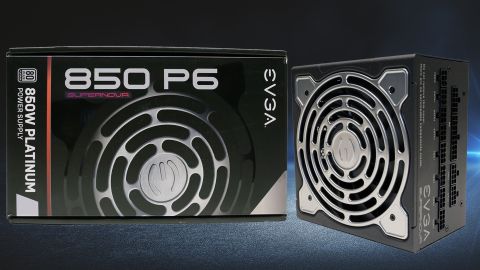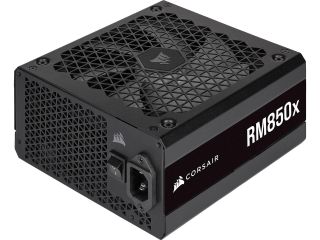Why you can trust Tom's Hardware
To learn more about our PSU tests and methodology, please check out How We Test Power Supply Units.
Primary Rails And 5VSB Load Regulation
The following charts show the main rails' voltage values recorded between a range of 40W up to the PSU's maximum specified load, along with the deviation (in percent). Tight regulation is an important consideration every time we review a power supply because it facilitates constant voltage levels despite varying loads. Tight load regulation also, among other factors, improves the system’s stability, especially under overclocked conditions and, at the same time, it applies less stress to the DC-DC converters that many system components utilize.








Load regulation is tight at 12V and satisfactory at 5V. However, it is pretty loose at 3.3V, where the platform didn't perform well as the similar capacity G6 unit. Someone could say that we measured on a loose pin, but we tried all 3.3V pins and found the one providing the best load regulation.
Hold-Up Time
Put simply; hold-up time is the amount of time that the system can continue to run without shutting down or rebooting during a power interruption.




The hold-up time is longer than the required (17ms), and the power-ok signal is accurate but lower than 16ms.
Inrush Current
Inrush current, or switch-on surge, refers to the maximum, instantaneous input current drawn by an electrical device when it is first turned on. A large enough inrush current can cause circuit breakers and fuses to trip. It can also damage switches, relays, and bridge rectifiers. As a result, the lower the inrush current of a PSU right as it is turned on, the better.


Inrush current is high with 230V.
Leakage Current
In layman's terms, leakage current is the unwanted transfer of energy from one circuit to another. In power supplies, it is the current flowing from the primary side to the ground or the chassis, which in the majority of cases is connected to the ground. For measuring leakage current, we use a GW Instek GPT-9904 electrical safety tester instrument.
The leakage current test is conducted at 110% of the DUT's rated voltage input (so for a 230-240V device, we should conduct the test with 253-264V input). The maximum acceptable limit of a leakage current is 3.5 mA and it is defined by the IEC-60950-1 regulation, ensuring that the current is low and will not harm any person coming in contact with the power supply's chassis.
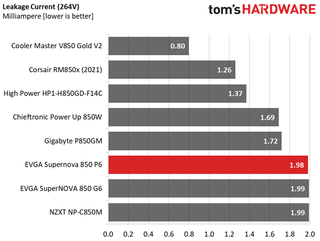
Leakage current is higher than most competing units, but still lower than the limit (3.5mA).
10-110% Load Tests
These tests reveal the PSU's load regulation and efficiency levels under high ambient temperatures. They also show how the fan speed profile behaves under increased operating temperatures.
| Test | 12V | 5V | 3.3V | 5VSB | DC/AC (Watts) | Efficiency | Fan Speed (RPM) | PSU Noise (dB[A]) | Temps (In/Out) | PF/AC Volts |
| 10% | 5.218A | 2A | 1.984A | 0.985A | 85.006 | 86.654% | 0 | <6.0 | 44.82°C | 0.966 |
| Row 2 - Cell 0 | 12.151V | 5V | 3.326V | 5.079V | 98.099 | Row 2 - Cell 6 | Row 2 - Cell 7 | Row 2 - Cell 8 | 39.84°C | 115.12V |
| 20% | 11.444A | 3.003A | 2.985A | 1.185A | 169.964 | 90.452% | 0 | <6.0 | 45.85°C | 0.983 |
| Row 4 - Cell 0 | 12.152V | 4.996V | 3.316V | 5.065V | 187.906 | Row 4 - Cell 6 | Row 4 - Cell 7 | Row 4 - Cell 8 | 40.52°C | 115.12V |
| 30% | 18.042A | 3.506A | 3.489A | 1.386A | 254.983 | 91.625% | 0 | <6.0 | 46.77°C | 0.983 |
| Row 6 - Cell 0 | 12.134V | 4.992V | 3.311V | 5.051V | 278.291 | Row 6 - Cell 6 | Row 6 - Cell 7 | Row 6 - Cell 8 | 41.17°C | 115.11V |
| 40% | 24.631A | 4.011A | 3.994A | 1.589A | 340.087 | 91.935% | 0 | <6.0 | 47.59°C | 0.985 |
| Row 8 - Cell 0 | 12.134V | 4.987V | 3.305V | 5.036V | 369.922 | Row 8 - Cell 6 | Row 8 - Cell 7 | Row 8 - Cell 8 | 41.42°C | 115.11V |
| 50% | 30.888A | 5.017A | 5.013A | 1.793A | 425.104 | 91.381% | 1413 | 40.4 | 42.31°C | 0.983 |
| Row 10 - Cell 0 | 12.127V | 4.984V | 3.292V | 5.02V | 465.202 | Row 10 - Cell 6 | Row 10 - Cell 7 | Row 10 - Cell 8 | 48.84°C | 115.11V |
| 60% | 37.093A | 6.028A | 6.035A | 1.998A | 509.641 | 90.992% | 1412 | 40.3 | 42.51°C | 0.984 |
| Row 12 - Cell 0 | 12.127V | 4.978V | 3.281V | 5.005V | 560.097 | Row 12 - Cell 6 | Row 12 - Cell 7 | Row 12 - Cell 8 | 49.73°C | 115.11V |
| 70% | 43.365A | 7.041A | 7.065A | 2.206A | 594.942 | 90.444% | 1411 | 40.3 | 43.58°C | 0.985 |
| Row 14 - Cell 0 | 12.125V | 4.973V | 3.27V | 4.989V | 657.801 | Row 14 - Cell 6 | Row 14 - Cell 7 | Row 14 - Cell 8 | 51.41°C | 115.11V |
| 80% | 49.634A | 8.003A | 8.101A | 2.311A | 679.492 | 89.762% | 1797 | 46.4 | 43.64°C | 0.987 |
| Row 16 - Cell 0 | 12.125V | 4.968V | 3.259V | 4.976V | 756.991 | Row 16 - Cell 6 | Row 16 - Cell 7 | Row 16 - Cell 8 | 52.38°C | 115.1V |
| 90% | 56.312A | 8.563A | 8.61A | 2.417A | 765.103 | 89.194% | 1796 | 46.4 | 44.68°C | 0.988 |
| Row 18 - Cell 0 | 12.121V | 4.964V | 3.252V | 4.966V | 857.792 | Row 18 - Cell 6 | Row 18 - Cell 7 | Row 18 - Cell 8 | 53.86°C | 115.09V |
| 100% | 62.685A | 9.078A | 9.154A | 3.037A | 849.921 | 88.456% | 1799 | 46.5 | 45.69°C | 0.989 |
| Row 20 - Cell 0 | 12.127V | 4.958V | 3.244V | 4.94V | 960.838 | Row 20 - Cell 6 | Row 20 - Cell 7 | Row 20 - Cell 8 | 55.65°C | 115.08V |
| 110% | 68.920A | 10.102A | 10.301A | 3.045A | 934.504 | 87.627% | 1801 | 46.4 | 46.8°C | 0.99 |
| Row 22 - Cell 0 | 12.133V | 4.95V | 3.232V | 4.928V | 1066.453 | Row 22 - Cell 6 | Row 22 - Cell 7 | Row 22 - Cell 8 | 57.62°C | 115.08V |
| CL1 | 0.115A | 14.544A | 14.788A | 0A | 121.313 | 82.927% | 1423 | 40.5 | 42.17°C | 0.977 |
| Row 24 - Cell 0 | 12.172V | 4.965V | 3.225V | 5.08V | 146.289 | Row 24 - Cell 6 | Row 24 - Cell 7 | Row 24 - Cell 8 | 49.88°C | 115.12V |
| CL2 | 0.115A | 24.236A | 0A | 0A | 121.425 | 81.225% | 1782 | 46.1 | 43.84°C | 0.977 |
| Row 26 - Cell 0 | 12.161V | 4.953V | 3.339V | 5.088V | 149.493 | Row 26 - Cell 6 | Row 26 - Cell 7 | Row 26 - Cell 8 | 51.67°C | 115.11V |
| CL3 | 0.115A | 0A | 25.133A | 0A | 80.582 | 73.945% | 1780 | 46.1 | 44.43°C | 0.968 |
| Row 28 - Cell 0 | 12.155V | 4.996V | 3.151V | 5.084V | 108.975 | Row 28 - Cell 6 | Row 28 - Cell 7 | Row 28 - Cell 8 | 53.27°C | 115.12V |
| CL4 | 70.097A | 0A | 0A | 0.001A | 849.609 | 89.316% | 1796 | 46.4 | 45.61°C | 0.989 |
| Row 30 - Cell 0 | 12.121V | 4.984V | 3.319V | 5.031V | 951.241 | Row 30 - Cell 6 | Row 30 - Cell 7 | Row 30 - Cell 8 | 55.39°C | 115.08V |
Similar to the 1000 P6, the passive operation lasted up to 40%. Again, the problem is that the fan starts to spin at high speeds afterward, making a loud noise.
20-80W Load Tests
In the following tests, we measure the PSU's efficiency at loads significantly lower than 10% of its maximum capacity (the lowest load the 80 PLUS standard measures). This is important for representing when a PC is idle with power-saving features turned on.
| Test | 12V | 5V | 3.3V | 5VSB | DC/AC (Watts) | Efficiency | Fan Speed (RPM) | PSU Noise (dB[A]) | Temps (In/Out) | PF/AC Volts |
| 20W | 1.228A | 0.499A | 0.494A | 0.196A | 20 | 78.78% | 0 | <6.0 | 40.43°C | 0.77 |
| Row 2 - Cell 0 | 12.092V | 5.008V | 3.341V | 5.107V | 25.387 | Row 2 - Cell 6 | Row 2 - Cell 7 | Row 2 - Cell 8 | 37.21°C | 115.11V |
| 40W | 2.702A | 0.699A | 0.692A | 0.294A | 40.001 | 84.638% | 0 | <6.0 | 41.25°C | 0.903 |
| Row 4 - Cell 0 | 12.098V | 5.007V | 3.338V | 5.102V | 47.261 | Row 4 - Cell 6 | Row 4 - Cell 7 | Row 4 - Cell 8 | 37.63°C | 115.11V |
| 60W | 4.158A | 0.899A | 0.89A | 0.392A | 60.002 | 84.805% | 0 | <6.0 | 42.77°C | 0.942 |
| Row 6 - Cell 0 | 12.152V | 5.005V | 3.336V | 5.098V | 70.752 | Row 6 - Cell 6 | Row 6 - Cell 7 | Row 6 - Cell 8 | 38.58°C | 115.11V |
| 80W | 5.622A | 1.099A | 1.089A | 0.491A | 79.957 | 86.968% | 0 | <6.0 | 43.84°C | 0.965 |
| Row 8 - Cell 0 | 12.154V | 5.003V | 3.333V | 5.093V | 91.938 | Row 8 - Cell 6 | Row 8 - Cell 7 | Row 8 - Cell 8 | 39.27°C | 115.11V |
Efficiency is high at light loads.
2% or 10W Load Test
From July 2020, the ATX spec requires 70% and higher efficiency with 115V input. The applied load is only 10W for PSUs with 500W and lower capacities, while for stronger units, we dial 2% of their max-rated capacity.
| 12V | 5V | 3.3V | 5VSB | DC/AC (Watts) | Efficiency | Fan Speed (RPM) | PSU Noise (dB[A]) | Temps (In/Out) | PF/AC Volts |
| 1.224A | 0.25A | 0.25A | 0.052A | 17.147 | 76.551% | 0 | <6.0 | 26.28°C | 0.729 |
| 12.082V | 5.013V | 3.338V | 5.111V | 22.399 | Row 2 - Cell 5 | Row 2 - Cell 6 | 28.21°C | 115.12V |
The PSU achieves sky-high efficiency with 2% of its max-rated capacity.
Efficiency & Power Factor
Next, we plotted a chart showing the PSU's efficiency at low loads and loads from 10 to 110% of its maximum rated capacity. The higher a PSU’s efficiency, the less energy goes wasted, leading to a reduced carbon footprint and lower electricity bills. The same goes for Power Factor.






Efficiency is high on all load ranges. On the other hand, the APFC converter needs boosting for higher PF readings, especially with 230V input.
5VSB Efficiency
| Test # | 5VSB | DC/AC (Watts) | Efficiency | PF/AC Volts |
| 1 | 0.1A | 0.511W | 72.577% | 0.064 |
| Row 2 - Cell 0 | 5.114V | 0.704W | Row 2 - Cell 3 | 115.11V |
| 2 | 0.25A | 1.278W | 76.464% | 0.143 |
| Row 4 - Cell 0 | 5.11V | 1.671W | Row 4 - Cell 3 | 115.12V |
| 3 | 0.55A | 2.807W | 78.143% | 0.248 |
| Row 6 - Cell 0 | 5.103V | 3.592W | Row 6 - Cell 3 | 115.12V |
| 4 | 1A | 5.092W | 78.019% | 0.348 |
| Row 8 - Cell 0 | 5.091V | 6.527W | Row 8 - Cell 3 | 115.12V |
| 5 | 1.5A | 7.62W | 78.396% | 0.405 |
| Row 10 - Cell 0 | 5.08V | 9.72W | Row 10 - Cell 3 | 115.12V |
| 6 | 3A | 15.093W | 76.478% | 0.484 |
| Row 12 - Cell 0 | 5.03V | 19.735W | Row 12 - Cell 3 | 115.12V |


The 5VSB rail should be more efficient.
Power Consumption In Idle And Standby
| Mode | 12V | 5V | 3.3V | 5VSB | Watts | PF/AC Volts |
| Idle | 12.074V | 5.015V | 3.34V | 5.115V | 2.936 | 0.204 |
| Row 2 - Cell 0 | Row 2 - Cell 1 | Row 2 - Cell 2 | Row 2 - Cell 3 | Row 2 - Cell 4 | Row 2 - Cell 5 | 115.12V |
| Standby | Row 3 - Cell 1 | Row 3 - Cell 2 | Row 3 - Cell 3 | Row 3 - Cell 4 | 0.061 | 0.005 |
| Row 4 - Cell 0 | Row 4 - Cell 1 | Row 4 - Cell 2 | Row 4 - Cell 3 | Row 4 - Cell 4 | Row 4 - Cell 5 | 115.12V |


Vampire power is low with 115V input, but above 0.1W with 230V.
Fan RPM, Delta Temperature, And Output Noise
All results are obtained between an ambient temperature of 37 to 47 degrees Celsius (98.6 to 116.6 degrees Fahrenheit).


The fan speed profile should be more refined. The unit operates in passive mode up to 40% load, and suddenly its fan speed increases to 1400RPM, where noise output is high.
The following results were obtained at 30 to 32 degrees Celsius (86 to 89.6 degrees Fahrenheit) ambient temperature.
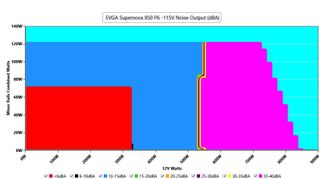
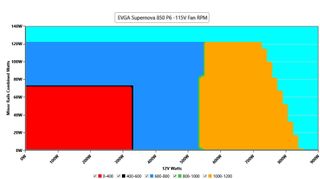
At normal operating temperatures, close to 30 degrees Celsius, the PSU passive operation lasts up to 330W, with the load on the minor rails staying below 70W. The problem here is the sudden transition at around 550W, from the 10-15 dBA range to above 35 dBA noise output. The fan speed profile should be smoother.
MORE: Best Power Supplies
MORE: How We Test Power Supplies
MORE: All Power Supply Content
Current page: Load Regulation, Hold-Up Time, Inrush and Leakage Current, Efficiency and Noise
Prev Page Specifications and Part Analysis Next Page Protection Features, DC Power Sequencing, Cross-Load Tests and Infrared ImagesAris Mpitziopoulos is a Contributing Editor at Tom's Hardware US, covering PSUs.
-
Co BIY Thanks - I've been asking for this review.Reply
Hard to beat the Corsair RMx 850 right now when it is shipping direct from them at $115.
I think a discussion at the beginning of each review that hits on the right use case for the power supply would be helpful. Do I need a 850 Watt power supply ? Is there any advantage to going lower or is this supply just as efficient all the way down the ladder so that getting the optimum wattage isn't that important?
